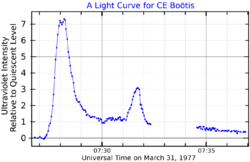Astronomy:Gliese 569
Coordinates: ![]() 14h 54m 29.2359s, +16° 06′ 03.7988″
14h 54m 29.2359s, +16° 06′ 03.7988″
| Observation data {{#ifeq:J2000|J2000.0 (ICRS)|Epoch J2000.0 Equinox J2000.0 (ICRS)| Epoch J2000 [[Astronomy:Equinox (celestial coordinates)|Equinox J2000}} | |
|---|---|
| Constellation | Boötes |
| A | |
| Right ascension | 14h 54m 29.2362s[2] |
| Declination | +16° 06′ 03.798″[2] |
| Apparent magnitude (V) | 10.15[3] |
| B | |
| Right ascension | 14h 54m 29.7686s[4] |
| Declination | +16° 06′ 05.627″[4] |
| Apparent magnitude (V) | |
| Characteristics | |
| BD+16 2708A | |
| Evolutionary stage | main-sequence star |
| Spectral type | M3 |
| Apparent magnitude (g) | 9.12[2] |
| Variable type | Flare star[5] |
| BD+16 2708B | |
| Spectral type | M8.5+M9[6] |
| Apparent magnitude (g) | 15.32[4] |
| Astrometry | |
| A | |
| Radial velocity (Rv) | −8.00±0.17 km/s |
| Proper motion (μ) | RA: +279.12±0.02[2] mas/yr Dec.: −117.91±0.02[2] mas/yr |
| Parallax (π) | 100.5243 ± 0.0210[2] mas |
| Distance | 32.446 ± 0.007 ly (9.948 ± 0.002 pc) |
| Orbit[7] | |
| Primary | GJ 569Ba |
| Companion | GJ 569Bb |
| Period (P) | 863.7±4.2 d |
| Semi-major axis (a) | 0.89±0.02 AU |
| Eccentricity (e) | 0.312±0.007 |
| Inclination (i) | 32.4±1.3° |
| Details[8] | |
| Gliese 569A | |
| Mass | 0.48 M☉ |
| Radius | 0.43 R☉ |
| Rotation | 14.7 d |
| Age | <700[6] Myr |
| Gliese 569B | |
| Mass | 0.081+0.059[9] M☉ |
| Radius | 1.69+1.28 RJup |
| Temperature | 2000+2000[6] K |
| Rotational velocity (v sin i) | 19+6[6] km/s |
| Age | <700[6] Myr |
| Other designations | |
| Database references | |
| SIMBAD | data |
| B | |
Gliese 569 is a ternary star system composed of a main-sequence star orbited by a pair of brown dwarfs in the constellation of Boötes about 32 light years away.
System
The primary star GJ 569A is orbited by the much fainter (3.7 magnitudes) secondary GJ 659B at a projected separation of 5.92 arcseconds, discovered in 1988.[11] The star GJ 569B (BD+16 2708B) itself is a close binary system of two high-mass brown dwarfs in a 2.4-year orbit,[12] and a small (0.538±0.048) magnitude difference between components.[13] The orbital plane of close binary GJ 569Ba and GJ 569Bb is expected to precess at timescales of about 100 thousand years due to the gravitational influence of GJ 569A.[6]
Properties
The primary star Gliese 569A is a flare star.[1] The nature of the brown dwarf binary Gliese 569B is highly uncertain, and it was even suspected Gliese 569Ba itself may be either a low-mass star or a binary object.[7] Both brown dwarfs are weakly variable, likely due to starspot activity.[12]
References
- ↑ 1.0 1.1 Hansen, O. L.; Veeder, G. L. (June 1977), "Flare Activity on Gl 569", Information Bulletin on Variable Stars 1292 (1): 1, Bibcode: 1977IBVS.1292....1H
- ↑ 2.0 2.1 2.2 2.3 2.4 Brown, A. G. A. (2021). "Gaia Early Data Release 3: Summary of the contents and survey properties". Astronomy & Astrophysics 649: A1. doi:10.1051/0004-6361/202039657. Bibcode: 2021A&A...649A...1G. Gaia EDR3 record for this source at VizieR.
- ↑ Koen, C. et al. (April 21, 2010), "UBV(RI)CJHK observations of Hipparcos-selected nearby stars", Monthly Notices of the Royal Astronomical Society 403 (4): 1949–1968, doi:10.1111/j.1365-2966.2009.16182.x, Bibcode: 2010MNRAS.403.1949K
- ↑ 4.0 4.1 4.2 Brown, A. G. A. (2021). "Gaia Early Data Release 3: Summary of the contents and survey properties". Astronomy & Astrophysics 649: A1. doi:10.1051/0004-6361/202039657. Bibcode: 2021A&A...649A...1G. Gaia EDR3 record for this source at VizieR.
- ↑ Samus, N. N. et al. (2009), "VizieR Online Data Catalog: General Catalogue of Variable Stars (Samus+ 2007-2013)", VizieR On-line Data Catalog: B/GCVS. Originally Published in: 2009yCat....102025S 1: B/gcvs, Bibcode: 2009yCat....102025S
- ↑ 6.0 6.1 6.2 6.3 6.4 6.5 Konopacky, Q. M.; Ghez, A. M.; Fabrycky, D. C.; MacIntosh, B. A.; White, R. J.; Barman, T. S.; Rice, E. L.; Hallinan, G. et al. (May 2012), "Rotational velocities of individual components in very low mass binaries", The Astrophysical Journal 750 (1): 14, doi:10.1088/0004-637X/750/1/79, Bibcode: 2012ApJ...750...79K
- ↑ 7.0 7.1 Simon, M.; Bender, C.; Prato, L. (June 2006), "The Gl569 multiple system", The Astrophysical Journal 644 (2): 1183–1192, doi:10.1086/503867, Bibcode: 2006ApJ...644.1183S
- ↑ Lund, K.; Jardine, M.; Russell, A J B.; Donati, J-F; Fares, R.; Folsom, C. P.; Jeffers, S. V.; Marsden, S. C. et al. (April 2021), "Field linkage and magnetic helicity density", Monthly Notices of the Royal Astronomical Society 502 (4): 4903–4910, doi:10.1093/mnras/stab305, Bibcode: 2021MNRAS.502.4903L
- ↑ Femenía, B.; Rebolo, R.; Pérez-Prieto, J. A.; Hildebrandt, S. R.; Labadie, L.; Pérez-Garrido, A.; Béjar, V. J. S.; Díaz-Sánchez, A. et al. (May 2011), "Lucky imaging adaptive optics of the brown dwarf binary GJ569Bab", Monthly Notices of the Royal Astronomical Society 413 (3): 1524–1536, doi:10.1111/j.1365-2966.2011.18226.x, Bibcode: 2011MNRAS.413.1524F
- ↑ "BD+16 2708". SIMBAD. Centre de données astronomiques de Strasbourg. http://simbad.u-strasbg.fr/simbad/sim-basic?Ident=BD%2B16+2708.
- ↑ Forrest, Skrutskie and Shure (1988), "A possible brown dwarf companion to Gliese 569", Astrophysical Journal Letters 330 (3): L119–L123, doi:10.1111/j.1365-2966.2011.18226.x, Bibcode: 2011MNRAS.413.1524F
- ↑ 12.0 12.1 Kenworthy, Matthew A.; Scuderi, Louis J. (June 2012), "Infrared variability of the Gliese 569B system", The Astrophysical Journal 752 (2): 131, doi:10.1088/0004-637X/752/2/131, Bibcode: 2012ApJ...752..131K
- ↑ Beltramo-Martin, O.; Correia, C. M.; Ragland, S.; Jolissaint, L.; Neichel, B.; Fusco, T.; Wizinowich, P. L. (August 2019), "PRIME: PSF Reconstruction and Identification for Multiple-source characterization Enhancement - application to Keck NIRC2 imager", Monthly Notices of the Royal Astronomical Society 487 (4): 5450–5462, doi:10.1093/mnras/stz1667, Bibcode: 2019MNRAS.487.5450B
 |


